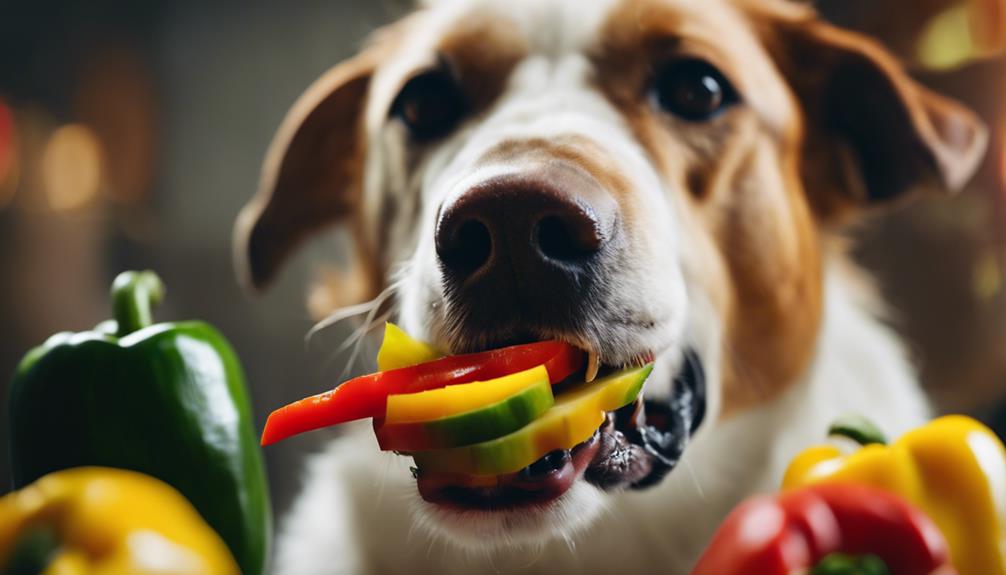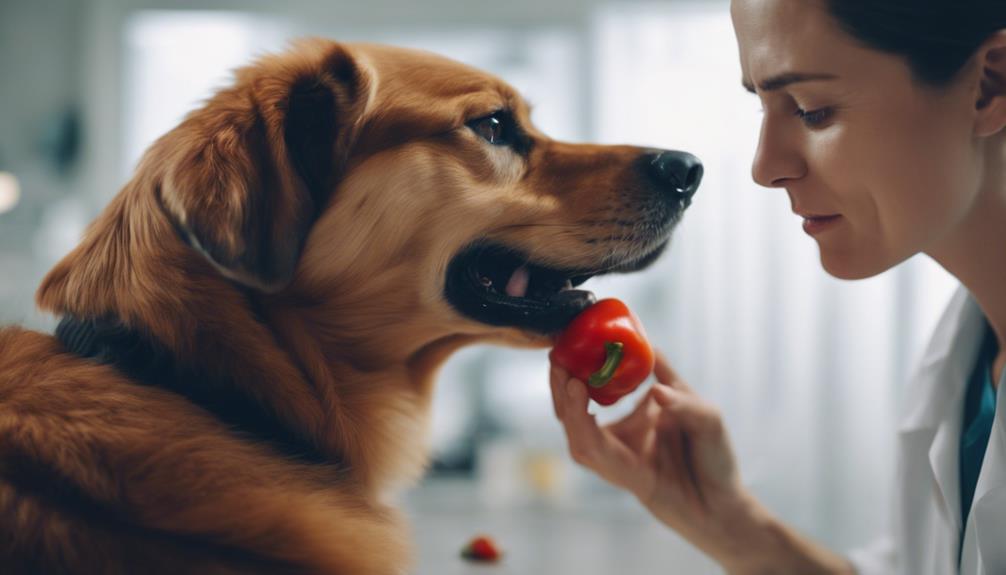Exploring the dietary options for our canine companions often leads to intriguing debates regarding the safety and benefits of specific foods. When it comes to bell peppers, canines' consumption of this colorful vegetable raises interesting considerations.
A vet's perspective on whether dogs can eat bell peppers sheds light on the potential impact on their health and well-being.
Understanding the nuances of this topic might influence how pet owners view the inclusion of bell peppers in their furry friends' meals.
Key Takeaways
- Dogs can safely eat all colors of bell peppers, providing fiber, vitamins, and minerals for overall health.
- Red bell peppers are the healthiest choice due to higher nutrient levels.
- Bell peppers should be given in moderation, limiting to 10% of daily treat calories.
- Prepare bell peppers by removing stems and cutting into small, safe pieces for your dog to enjoy.
Safety of Bell Peppers for Dogs
Bell peppers are deemed safe for canine consumption, providing numerous health benefits when included in moderation in a dog's diet. All colors of bell peppers can be fed to dogs, with red bell peppers being the healthiest due to their higher levels of beta-carotene, potassium, folate, and lutein.
These vegetables offer fiber for weight loss and digestive health, beta-carotene for eye health, vitamin E for skin and coat health, and vitamin C for immune function. When feeding bell peppers to dogs, it is essential to follow feeding guidelines, limiting them to 10% of the daily treat calories.
Additionally, preparation and serving tips such as removing stems and leaves, cutting them into small pieces, and avoiding seasonings like onions and garlic should be followed to ensure the safety of your canine companion.
Health Benefits of Bell Peppers
Rich in essential nutrients and antioxidants, bell peppers offer a range of health benefits for dogs when incorporated sensibly into their diet. These colorful vegetables provide fiber, promoting weight loss and aiding in digestive health.
Bell peppers are a great source of beta-carotene, crucial for eye health, as well as vitamin E, which contributes to skin and coat health. Additionally, the vitamin C content in bell peppers supports immune function in dogs.
Among the different colors, red bell peppers stand out as the healthiest option due to their higher levels of beta-carotene, potassium, folate, and lutein. Including bell peppers in your dog's diet can contribute to their overall well-being and provide a tasty and nutritious treat option.
Nutritional Value of Bell Peppers

Incorporating bell peppers into a dog's diet provides a spectrum of essential nutrients and antioxidants, contributing to their overall health and well-being. Here are three key nutritional benefits of bell peppers for dogs:
- Vitamin C: Bell peppers are rich in vitamin C, which boosts the immune system and helps in wound healing.
- Vitamin A: These peppers contain beta-carotene, a precursor to vitamin A, essential for vision health and immune function.
- Fiber: Bell peppers are a good source of dietary fiber, aiding in digestion and promoting a healthy weight.
These nutrients make bell peppers a valuable addition to a dog's diet when introduced in moderation and following proper guidelines.
Importance of Fiber in Bell Peppers
A significant aspect of the nutritional profile of bell peppers lies in their high fiber content, which plays a crucial role in supporting digestive health in dogs. Fiber aids in promoting healthy digestion by regulating bowel movements, preventing constipation, and maintaining a healthy gut microbiome. Additionally, it can help dogs feel full and satisfied, which may be beneficial for weight management. Ensuring an adequate fiber intake from sources like bell peppers can contribute to overall well-being in dogs.
| Benefits of Fiber in Bell Peppers | Description |
|---|---|
| Regulates bowel movements | Supports digestive health |
| Prevents constipation | Helps in weight management |
| Maintains a healthy gut microbiome | Promotes overall well-being |
Feeding Guidelines for Dogs

To ensure the optimal nutritional balance for dogs, it is essential to establish appropriate feeding guidelines when incorporating bell peppers into their diet.
Feeding Guidelines for Dogs:
- Bell peppers should be given in moderation, limiting to 10% of daily treat calories.
- Start with a small amount to ensure your dog enjoys it and has no digestive issues.
- Small dogs can have up to a quarter of a pepper, while large dogs can have up to half daily.
Following these guidelines will help prevent any potential digestive upsets and ensure that your dog benefits from the nutritional value that bell peppers can provide.
Moderation in Bell Pepper Consumption
Establishing a balanced approach to bell pepper consumption is crucial in ensuring the well-being of dogs, particularly focusing on moderation to maintain their overall health.
While bell peppers offer various health benefits, including fiber, vitamins, and antioxidants, overfeeding can lead to digestive upset or an imbalance in their diet. It is recommended to limit bell peppers to no more than 10% of a dog's daily treat calories.
Small dogs can typically have up to a quarter of a pepper, while larger dogs can consume up to half daily. By incorporating bell peppers into their diet in moderation, pet owners can provide a nutritious addition to their canine companion's meals without risking any adverse effects on their health.
Bell Peppers for Small Dogs

When considering bell peppers as a dietary addition for small dogs, moderation and proper portion control are essential factors to ensure their well-being. Here are three key points to keep in mind when feeding bell peppers to small dogs:
- Portion Size: Small dogs can have up to a quarter of a bell pepper daily, ensuring that it does not exceed 10% of their treat calories.
- Digestive Monitoring: Start with a small amount of bell pepper to monitor your small dog's digestive response and ensure they tolerate it well.
- Cutting and Preparation: Cut the bell pepper into small, bite-sized pieces to prevent choking hazards, making it easier for small dogs to chew and digest.
Bell Peppers for Large Dogs
Considering the dietary needs of large dogs, incorporating bell peppers can provide a range of health benefits when introduced in appropriate quantities. Large dogs can enjoy up to half a bell pepper daily, reaping the nutritional advantages such as fiber for weight management, beta-carotene for eye health, and vitamin C for immune support. To better understand the nutritional content of bell peppers for large dogs, refer to the table below:
| Nutrient | Health Benefit |
|---|---|
| Fiber | Weight management and digestive health |
| Beta-Carotene | Eye health |
| Vitamin C | Immune function support |
Preparation Tips for Bell Peppers

To ensure the safe and enjoyable consumption of bell peppers by dogs, proper preparation techniques are essential. Here are some tips to prepare bell peppers for your canine companion:
- Remove stems and seeds: Make sure to eliminate all stems, seeds, and core from the bell peppers before feeding them to your dog to prevent any choking hazards.
- Cut into small pieces: Cutting the bell peppers into small, manageable pieces can help avoid any potential choking risks and make it easier for your dog to chew and digest.
- Consider cooking or steaming: Cooking or steaming the bell peppers can soften them, making them easier for your dog to chew and digest, while also enhancing the flavor.
Serving Tips for Bell Peppers
For optimal serving of bell peppers to dogs, ensure to offer them in small, bite-sized pieces to prevent choking hazards and facilitate easy consumption and digestion. This cutting method is especially important for small dogs or those prone to gulping food quickly.
Additionally, consider cooking or steaming the bell peppers to soften them, making it easier for dogs to chew and digest. By removing all stems and seeds beforehand, you can further reduce the risk of any digestive issues.
Remember to avoid seasoning the bell peppers with any toxic ingredients like onions or garlic. These serving tips will help ensure that your furry friend can safely enjoy the nutritional benefits of bell peppers without any adverse effects.
Comparison With Hot Peppers

When evaluating the suitability of bell peppers for canine consumption, it is crucial to distinguish between the safety of bell peppers and the potential harm posed by hot peppers like chili and jalapeño due to the presence of capsaicin.
Bell peppers are safe for dogs to consume in moderation.
Hot peppers like chili and jalapeño contain capsaicin, which can cause gastrointestinal upset and other health issues in dogs.
The spiciness of hot peppers can be overwhelming for dogs, potentially leading to discomfort and digestive problems.
Cooking Bell Peppers Safely
Consider incorporating bell peppers into your dog's diet through safe cooking techniques that enhance palatability and ease of consumption. Cooking or steaming bell peppers can make them softer and easier for your dog to chew, especially for puppies or senior dogs with dental issues.
When cooking bell peppers for your furry friend, avoid using toxic seasonings like garlic and onions. Opt for simple preparation methods to maintain the health benefits of bell peppers without adding unnecessary fats or spices.
Managing Bell Pepper Quantity
In optimizing your dog's nutritional intake, prudent management of bell pepper quantity is essential for maintaining a balanced diet that aligns with their daily treat calorie limit. When incorporating bell peppers into your dog's diet, consider the following:
- Moderation is Key: Limit bell peppers to 10% of your dog's daily treat calories to prevent overconsumption.
- Size Matters: Small dogs can have up to a quarter of a pepper, while large dogs can have up to half daily to ensure appropriate portion sizes.
- Monitor Intake: Watch for any digestive issues or changes in your dog's behavior when introducing bell peppers, adjusting the quantity as needed to suit their individual tolerance levels.
Conclusion
In conclusion, bell peppers can be a safe and beneficial addition to a dog's diet when given in moderation and prepared properly. They offer various health benefits, including essential nutrients and fiber.
By following feeding guidelines, serving tips, and cooking them safely, pet owners can incorporate bell peppers into their furry companions' meals. It is important to manage the quantity of bell peppers given to dogs to ensure their overall well-being and health.




